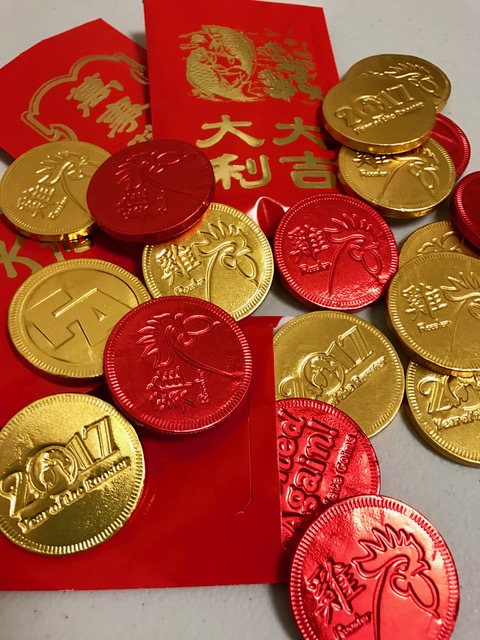
Chinese New Year, or Lunar New Year as it is often called, begins on January 28th in 2017. Each year is represented by one of 12 zodiac animals. This year, the star of the show is the Fire Rooster.
Think of Chinese New Year and many images come to mind. The dragon and lion dances in the streets, family feasts, house cleaning to sweep out any bad spirits and of course, the ubiquitous red envelopes.
In China, red envelopes are presented as gifts at New Year as a wish for good luck in the coming year. This custom is also observed outside the Chinese mainland wherever large ethnic Chinese populations dwell. They are called hongbao in Mandarin and lai see in Cantonese. The term “red packets” has also come into common use, though hongbao look and function more like envelopes than packets.
The red envelopes usually contain money in some form, whether it be currency or in the form of chocolate coins wrapped in foil. The envelopes are mostly given to children and teens by parents, grandparents, and family friends. Unmarried people are not expected to participate in the tradition.
Origin of the Custom
During the Qin Dynasty (221-206 BC) in China, the elders used red string to thread coins for the purpose of warding off evil spirits. They believed the money would protect their young loved ones from sickness and death.
When printing presses became common, red envelopes with printed words replaced the bare coins. During this time. the message of the money changed from warding off evil spirits of death to warding off old age and bringing good fortune.
The Gift
Tradition calls for the amount of New Year money contained in a red envelope to be an even amount. Odd amounts of money are considered poor etiquette as they could bring bad luck.
Another Chinese tradition is that money should never be given in amounts of fours. Amounts such as 4, 40, or even 444 are forbidden gift amounts because the standard Mandarin Chinese word for four sounds very much like the word for death.
It’s also traditional to give only crisp, new bills inside the envelope. It’s considered poor taste to give dirty or wrinkled bills. This tradition is so ingrained that huge lines form at Chinese banks just before New Year so people can swap their old bills for new ones.
The Color Red
Red has long been a favorite color for the Chinese people. The color is revered as a symbol for energy, good luck and happiness. Giving monetary gifts in a red envelope expresses the wish of good luck and fortune to the recipient.
The red paper envelope is actually more significant than the money inside. By tradition, it is considered impolite to open a red envelope in front of the person you received the envelope from.
Besides Chinese New Year, it is common to give a red envelope during some special occasions, such as a wedding, graduation, the birth of a baby, or a senior person’s birthday. It is a traditional way to wish good luck and share blessings.
And if anyone hands you a red envelope, proper etiquette is to receive the envelope with both hands.
Happy Chinese New Year or as they say in China, Gung Hay Fat Choy!